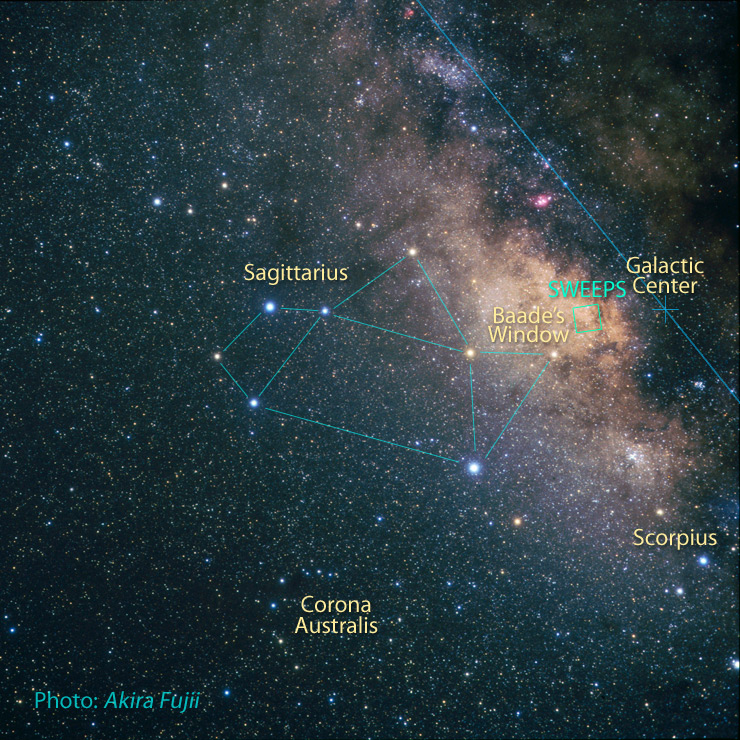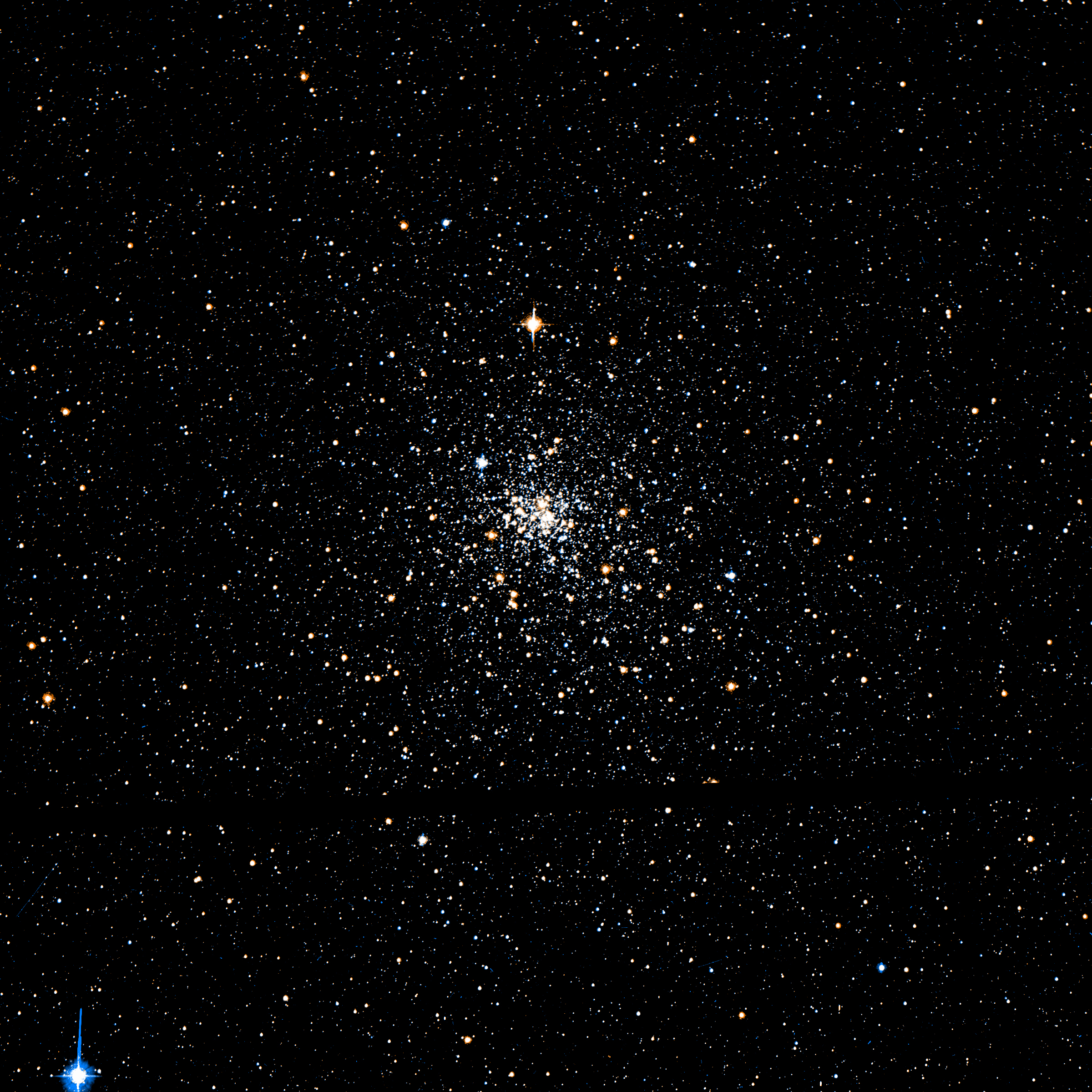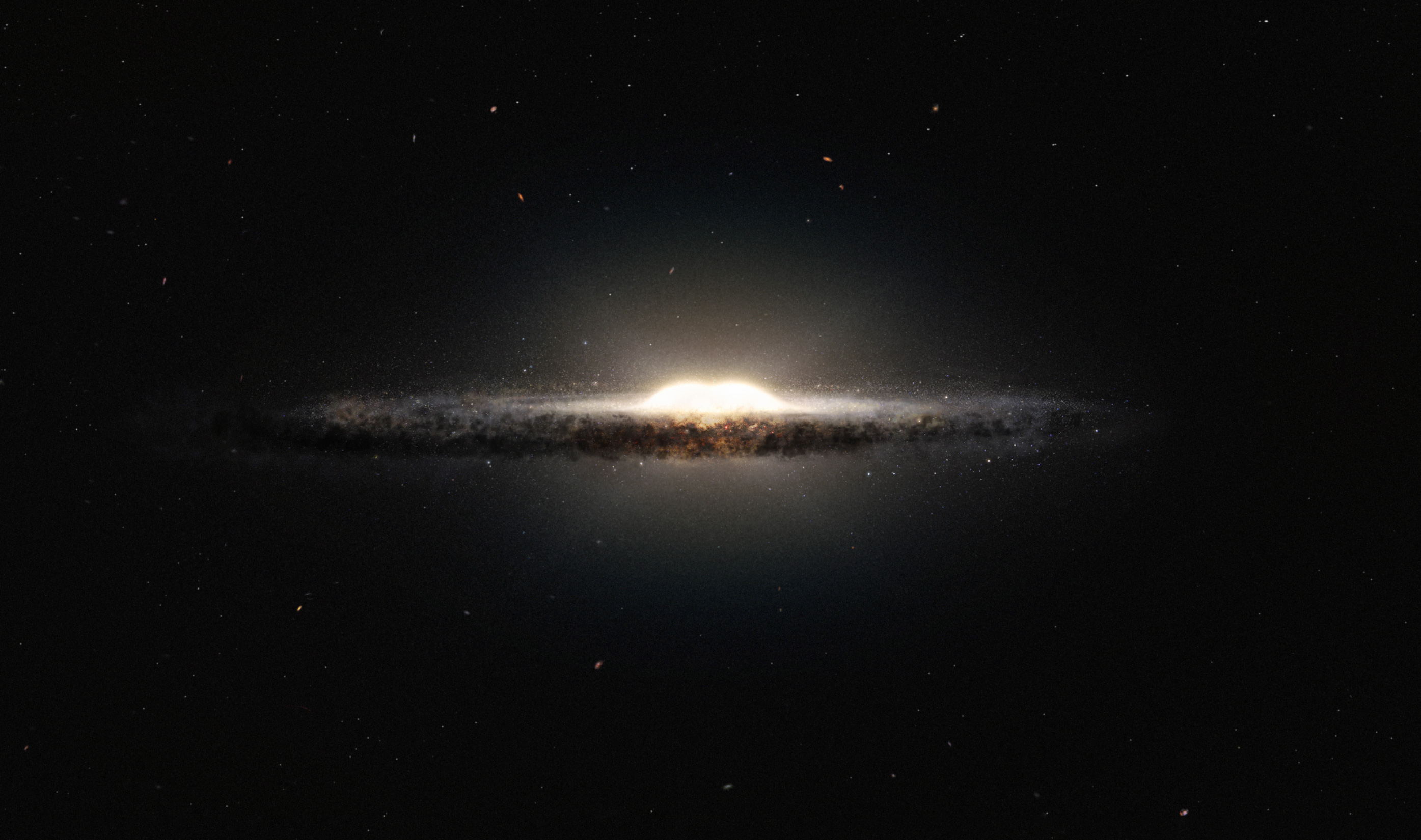|
Baade's Window
Baade's Window is an area of the sky with relatively low amounts of cosmic dust, interstellar dust along the line of sight from Earth. This area is considered an observational "window" as the normally obscured Galactic Center of the Milky Way is visible in this direction. It is named for astronomer Walter Baade, who first recognized its significance. This area corresponds to one of the brightest visible patches of the Milky Way. It is centered at a Galactic coordinate system#Galactic longitude, galactic longitude (') of 1.02° and a Galactic coordinate system#Galactic latitude, galactic latitude (') of -3.92°, which corresponds to a right ascension of 18h 03m 32.14s and a declination of -30d 02m 06.96s, in the direction of the constellation Sagittarius (constellation), Sagittarius. History Walter Baade observed the stars in this area in the mid-1940s using the Hooker telescope at Mount Wilson Observatory in California while searching for the center of the Milky Way galaxy. Up un ... [...More Info...] [...Related Items...] OR: [Wikipedia] [Google] [Baidu] |
HST SWEEPS Galaxy Location-2006
HST may refer to: Science and technology * The Hubble Space Telescope * Harvard–MIT Program of Health Sciences and Technology * The history of science and technology * High-speed telegraphy, a radiosport * High-Speed Transfer, a USRobotics modem protocol * Highstand systems tract, in the Sequence stratigraphy#Systems tracts, sequence stratigraphy branch of geology Transportation * Helsinki City Transport (Swedish: ') * Heritage Shunters Trust, an English rail preservation society * InterCity 125 or High Speed Train, UK * High Street (Glasgow) railway station, Scotland, station code Other uses * Half-Square or Half Square Triangle a block in quilting *Harmonized sales tax, in Canada * Hawaii-Aleutian Standard Time (UTC−10) * Hegemonic stability theory, in international relations * Helicopter support team, in the United States Marine Corps * High Sierra Trail, in California, United States * Holden Street Theatres, Adelaide, Australia * Homestead Air Reserve Base, Flor ... [...More Info...] [...Related Items...] OR: [Wikipedia] [Google] [Baidu] |
Astronomical Survey
An astronomical survey is a general map or image of a region of the sky (or of the whole sky) that lacks a specific observational target. Alternatively, an astronomical survey may comprise a set of images, spectra, or other observations of objects that share a common type or feature. Surveys are often restricted to one band of the electromagnetic spectrum due to instrumental limitations, although multiwavelength surveys can be made by using multiple detectors, each sensitive to a different bandwidth. Surveys have generally been performed as part of the production of an astronomical catalog. They may also search for transient astronomical events. They often use wide-field astrographs. Scientific value Sky surveys, unlike targeted observation of a specific object, allow astronomers to catalog celestial objects and perform statistical analyses on them without complex corrections for selection effects. In some cases, an astronomer interested in a particular object will find tha ... [...More Info...] [...Related Items...] OR: [Wikipedia] [Google] [Baidu] |
Large Sagittarius Star Cloud
The Large Sagittarius Star Cloud is the brightest visible region of the Milky Way galaxy, a portion of the central galactic bulge, bulge seen around the thick dust of the Great Rift (astronomy), Great Rift which lines the northwest edge. It should not be confused with the nearby Small Sagittarius Star Cloud, which lies about 10° to the north. The star cloud stretches several degrees north from the star Gamma Sagittarii and is considered a splendid sight in binoculars - "a bright glow with multitudes of momentarily resolved star-sparks". To the naked eye, the Cloud appears bright and smooth, and is said to resemble a puff of "steam" escaping from the spout of the Sagittarius (constellation), Sagittarius "Teapot" Asterism (astronomy), asterism. Properties The Large Sagittarius Star Cloud is the innermost galactic structure that can be observed in visible wavelengths, and the most distant portion of the Milky Way that can be seen with unaided eyes. Being depleted of the gas and du ... [...More Info...] [...Related Items...] OR: [Wikipedia] [Google] [Baidu] |
Zone Of Avoidance
The Zone of Avoidance (ZOA, ZoA), or Zone of Galactic Obscuration (ZGO), is the area of the sky that is obscured by the Milky Way. The Zone of Avoidance was originally called the Zone of Few Nebulae in an 1878 paper by English astronomer Richard Proctor that referred to the distribution of "nebulae" in John Herschel's '' General Catalogue of Nebulae''.Kraan-Korteweg & Lahav 2000, p. 2 Background When viewing space from Earth, the attenuation, interstellar dust and stars in the plane of the Milky Way (the galactic plane) obstruct the view of around 20% of the extragalactic sky at visible wavelengths. As a result, optical galaxy catalogues are usually incomplete close to the galactic plane. Modern developments Many projects have attempted to bridge the gap in knowledge caused by the Zone of Avoidance. The dust and gas in the Milky Way cause extinction at optical wavelengths, and foreground stars can be confused with background galaxies. However, the effect of extinction drops at lo ... [...More Info...] [...Related Items...] OR: [Wikipedia] [Google] [Baidu] |
Methods Of Detecting Extrasolar Planets
Any planet is an extremely faint light source compared to its parent star. For example, a star like the Sun is about a billion times as bright as the reflected light from any of the planets orbiting it. In addition to the intrinsic difficulty of detecting such a faint light source, the light from the parent star causes a glare that washes it out. For those reasons, very few of the exoplanets reported have been observed directly, with even fewer being resolved from their host star. Instead, astronomers have generally had to resort to indirect methods to detect extrasolar planets. As of 2016, several different indirect methods have yielded success. Established detection methods The following methods have at least once proved successful for discovering a new planet or detecting an already discovered planet: Radial velocity A star with a planet will move in its own small orbit in response to the planet's gravity. This leads to variations in the speed with which the star move ... [...More Info...] [...Related Items...] OR: [Wikipedia] [Google] [Baidu] |
Optical Gravitational Lensing Experiment
The Optical Gravitational Lensing Experiment (OGLE) is a Polish astronomical project based at the University of Warsaw that runs a long-term variability sky survey (1992–present). The main goals are the detection and classification of variable stars ( pulsating and eclipsing), discovery of microlensing events, dwarf novae, and studies of the structure of the Galaxy and the Magellanic Clouds. Since the project began in 1992, it has discovered a multitude of extrasolar planets, together with the first planet discovered using the transit method (OGLE-TR-56b) and gravitational microlensing. The project has been led by professor Andrzej Udalski since its inception. Description The main targets of the experiment are the Magellanic Clouds and the Galactic Bulge, because of the large number of intervening stars that can be used for microlensing during a stellar transit. Most of the observations have been made at the Las Campanas Observatory in Chile. Cooperating institutions includ ... [...More Info...] [...Related Items...] OR: [Wikipedia] [Google] [Baidu] |
NGC 6522
NGC 6522 is a globular cluster in the constellation Sagittarius. It is apparent magnitude 8.3, and diameter 16.4 arc minutes, and class VI with stars 16th magnitude and dimmer. It was discovered by William Herschel on June 24, 1784. It is centered in a region of the sky known as Baade's Window. NGC 6522 is possibly the oldest star cluster in the Milky Way, with an age of more than 12 billion years. '''' by David Shiga, 30 April 2011, p. 20 [...More Info...] [...Related Items...] OR: [Wikipedia] [Google] [Baidu] |
Globular Cluster
A globular cluster is a spheroidal conglomeration of stars. Globular clusters are bound together by gravity, with a higher concentration of stars towards their centers. They can contain anywhere from tens of thousands to many millions of member stars. Their name is derived from Latin (small sphere). Globular clusters are occasionally known simply as "globulars". Although one globular cluster, Omega Centauri, was observed in antiquity and long thought to be a star, recognition of the clusters' true nature came with the advent of telescopes in the 17th century. In early telescopic observations globular clusters appeared as fuzzy blobs, leading French astronomer Charles Messier to include many of them in his catalog of astronomical objects that he thought could be mistaken for comets. Using larger telescopes, 18th-century astronomers recognized that globular clusters are groups of many individual stars. Early in the 20th century the distribution of globular clusters in the sky w ... [...More Info...] [...Related Items...] OR: [Wikipedia] [Google] [Baidu] |
Bulge (astronomy)
In astronomy, a galactic bulge (or simply bulge) is a tightly packed group of stars within a larger star formation. The term almost exclusively refers to the central group of stars found in most spiral galaxies (see galactic spheroid). Bulges were historically thought to be elliptical galaxies that happened to have a disk of stars around them, but high-resolution images using the Hubble Space Telescope have revealed that many bulges lie at the heart of a spiral galaxy. It is now thought that there are at least two types of bulges: bulges that are like ellipticals and bulges that are like spiral galaxies. Classical bulges Bulges that have properties similar to those of elliptical galaxies are often called "classical bulges" due to their similarity to the historic view of bulges. These bulges are composed primarily of stars that are older, Population II stars, and hence have a reddish hue (see stellar evolution). These stars are also in orbits that are essentially random co ... [...More Info...] [...Related Items...] OR: [Wikipedia] [Google] [Baidu] |
N6522 32ins , a camera
{{Letter-NumberCombDisambig ...
N65 may refer to: Roads * N65 highway (Philippines) * N65 road (Ireland) * Nebraska Highway 65, in the United States Other uses * N65 (Long Island bus) * Escadrille N65, a unit of the French Air Force * , a S-class submarine of the Royal Navy sunk in 1940 * , a U-class submarine of the Royal Navy sunk in 1941 * London Buses route N65 * Nikon N65 (, ; ), also known just as Nikon, is a Japanese multinational corporation headquartered in Tokyo, Japan, specializing in optics and Photography, imaging products. The companies held by Nikon form the Nikon Group. Nikon's products include cam ... [...More Info...] [...Related Items...] OR: [Wikipedia] [Google] [Baidu] |
Centre De Données Astronomiques De Strasbourg
Center or centre may refer to: Mathematics *Center (geometry), the middle of an object * Center (algebra), used in various contexts ** Center (group theory) ** Center (ring theory) * Graph center, the set of all vertices of minimum eccentricity Places United States * Centre, Alabama * Center, Colorado * Center, Georgia * Center, Indiana * Center, Jay County, Indiana * Center, Warrick County, Indiana * Center, Kentucky * Center, Missouri * Center, Nebraska * Center, North Dakota * Centre County, Pennsylvania * Center, Portland, Oregon * Center, Texas * Center, Washington * Center, Outagamie County, Wisconsin * Center, Rock County, Wisconsin **Center (community), Wisconsin *Center Township (other) *Centre Township (other) *Centre Avenue (other) *Center Hill (other) Other countries * Centre region, Hainaut, Belgium * Centre Region, Burkina Faso * Centre Region (Cameroon) * Centre-Val de Loire, formerly Centre, France * Centre (department), H ... [...More Info...] [...Related Items...] OR: [Wikipedia] [Google] [Baidu] |
SIMBAD
SIMBAD (the Set of Identifications, Measurements and Bibliography for Astronomical Data) is an astronomical database of objects beyond the Solar System. It is maintained by the Centre de données astronomiques de Strasbourg (CDS), France. SIMBAD was created by merging the Catalog of Stellar Identifications (CSI) and the Bibliographic Star Index as they existed at the Meudon Computer Centre until 1979, and then expanded by additional source data from other catalogues and the academic literature. The first on-line interactive version, known as Version 2, was made available in 1981. Version 3, developed in the C language and running on UNIX stations at the Volgograd Observatory, was released in 1990. Fall of 2006 saw the release of Version 4 of the database, now stored in PostgreSQL, and the supporting software, now written entirely in Java. JP11 is a star catalogue containing about 4,000 objects. Currently it exists only as a part of the SIMBAD database. , SIMBAD contains informa ... [...More Info...] [...Related Items...] OR: [Wikipedia] [Google] [Baidu] |







